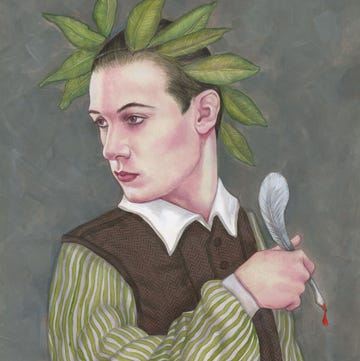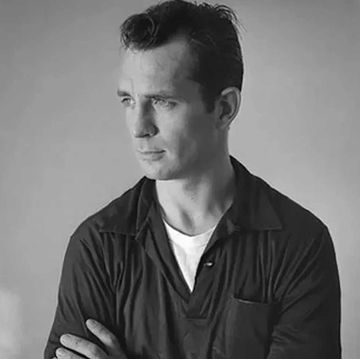Am I the only one to find the publication of Gil Cuadros’s My Body Is Paper: Stories and Poems a little bittersweet? Sweet because it feels miraculous to have another book by Cuadros, who died of AIDS in 1996, two years after the publication of his only previous collection, City of God; bitter because the author lived so briefly—34 years—and has been dead so long. Born and raised in Southern California, he fused in his work explorations of sexuality and ethnicity, and was among the first Latino writers to engage the subject of AIDS from the inside.
“She would cut out / what is wrong with me,” he declares in the poem “If She Could,” invoking his mother. “She’d leave the edges sharp, / a hollow space at my crotch, / my mouth clean of sperm.”
Such bluntness, such directness, recalls David Wojnarowicz, who in Memories That Smell Like Gasoline, published in 1992 as he too was dying of AIDS, addresses the attenuation of his existence, referring to himself as “completely empty…a xerox of my former self…a dark smudge in the air that dissipates without notice…a glass human disappearing in rain.” These images feel as if they are in conversation with the title of Cuadros’s book. Both, after all, are describing illness as erasure, absence, a gesture of removal, which only makes the language more immediate. What I mean is that in the work of both writers, the art of telling, all the scenes and details, becomes a mechanism of remembering, of self-preservation, made all the more powerful because the self cannot be preserved. Each has been gone now nearly as many years as he spent living. Each is, or can be, recollected only through the medium of the work.
City of God comes infused with such an impulse; Cuadros had been sick for more than six years when it appeared. After the death of his lover, John, in 1987, he found focus in a workshop for HIV-positive writers taught by the literary artist Terry Wolverton at the Los Angeles Gay and Lesbian Center. Wolverton, along with Pablo Alvarez, Kevin J. Martin, and Rafael Pérez-Torres, has edited My Body Is Paper, which also features an afterword by Alvarez and a foreword by Justin Torres, who writes, “Take this paper and read it, this is his body, broken for us. Do this in remembrance of Gil.”
Paper, in other words, as disposable and lasting, a metaphor for the ephemera of the body, but also for the testament of narrative.
In City of God, those narratives are delineated, prose and poetry, divided into parts. The first gathers nine stories, coming of age and what happens after; “Son,” a priest tells the protagonist of “Letting Go,” “it is time to go, last rites, you need to live in the city of God.” To round out the collection, Cuadros adds a suite of poems, more directly autobiographical, including an extended sequence, “The Quilt Series,” which offers a moment-by-moment rendering of John’s final days.
My Body Is Paper also moves back and forth between verse and what the editors call stories, but the boundaries are more fluid. In the first place, the poems and narratives are not separated but rather run in and out of one another; in the second, the line between fiction and nonfiction blurs. Whereas among its stories City of God features one, “Baptism,” narrated by a young woman, and another, “Indulgences,” about a trip to Merced for a family funeral, the terms here are a bit more elusive, which I mean as a compliment. It’s as if we are getting a glimpse at the writer Cuadros was in the process of becoming; much of this material was developed after City of God appeared.
Writing, again, as a gesture of survival, testimony. Writing as a necessary act.
“I am prepared,” My Body Is Paper opens. “I have had my will drawn and notarized. I’ve given away old books from my library that I will never read again.” The editors are signaling that this is a book of last things, which is also, I want to imagine, what the author has in mind. I want to be careful about how I say this; I am not suggesting a presence from beyond the grave. All the same, I want to note that it is impossible to read My Body Is Paper without being aware of the book’s intention, which is to say Cuadros’s intention as well. In this work, he is writing with a vivid urgency because he knows he has no time to waste. The people in these pieces carry their real names, their real relationships, from his ex, Kevin, to his partner, Marcus, who in the collection’s final poem, “1-800-BELOVED,” leaves Cuadros “with the worst memories of his passing / …the crying, the screaming, / the tears that scar the face, the nausea, the refusal to live, / and the strength of my legs still walking this bitter earth.”
There is, in that moment, an echo of “The Quilt Series,” with its related refusal. “Damn it you’re wrong,” the poet insists of John, “he can’t be dead.” It’s a continuity as powerful as it is unexpected, especially in a volume necessarily constructed out of odds and ends. Two-thirds of the way through My Body Is Paper, the editors introduce a piece called “Heroes.” “We believe these pages are the beginning of a novel or novella that was left unfinished when Cuadros died,” they write. “His moving into long-form prose signals the work we might have seen from him had he lived.” Such a statement highlights the conjecture, the conditionality, at the heart of every reclamation project. Yet if My Body Is Paper has anything to tell us, it is that Cuadros had already arrived. Again and again, I found myself reading as if this were less a collection than a collage, a narrative in installments, in which the flow, the movement, remains directed and distinct. “Heroes” represents a case in point, portraying Marcus and Kevin, as well as Cuadros’s health issues, refracting situations we have encountered elsewhere in the book. It’s not repetition so much as a subtle patterning, the slow accretion of experience. In that regard, My Body Is Paper adds up not to a novel or a novella but rather to an autofiction, a set of narratives that together comprise a life.
That idea takes a resounding turn in a short prose piece called “Birth,” where an unnamed narrator a lot like Cuadros (among other things, he lives with a man named Marcus) becomes if not pregnant precisely, then what let’s call with child. The religious references are front and center. “My lover thinks he is a lowly Joseph,” Cuadros writes, “not important in the scheme of this miracle.” Meanwhile, out in the street, the narrator faces disgust and consternation, “filthy looks, the kind I imagine Jesus encountered on his trek to Calvary.”
And yet, in his faith and perseverance, he achieves a kind of holiness. What’s most essential is the miracle itself.
I want to think of My Body Is Paper as that child, gestating unborn for 30 years. It is so much more than a collection of posthumous writing. It is so much more than a whisper of what might have been. Rather, this is a book that functions as both testament and epitaph while enlarging our appreciation of just how beautiful an artist Cuadros was. “I feel it well up inside of me,” he writes in “Birth,” and as we read these pages, we cannot help but feel it too.•













